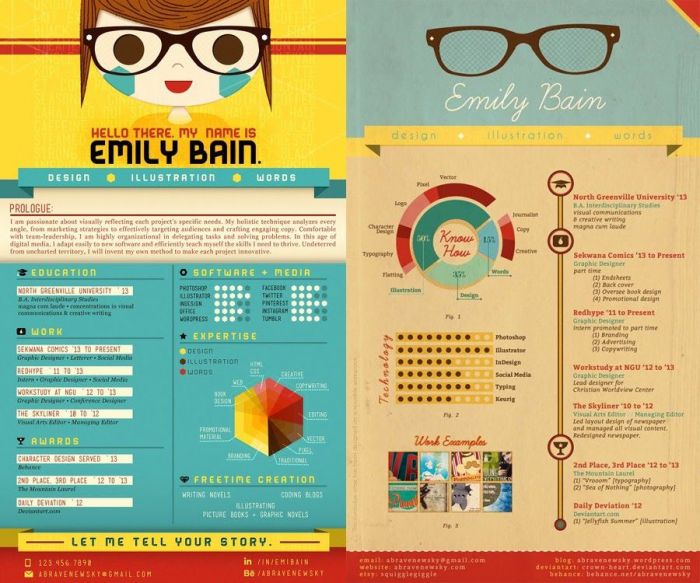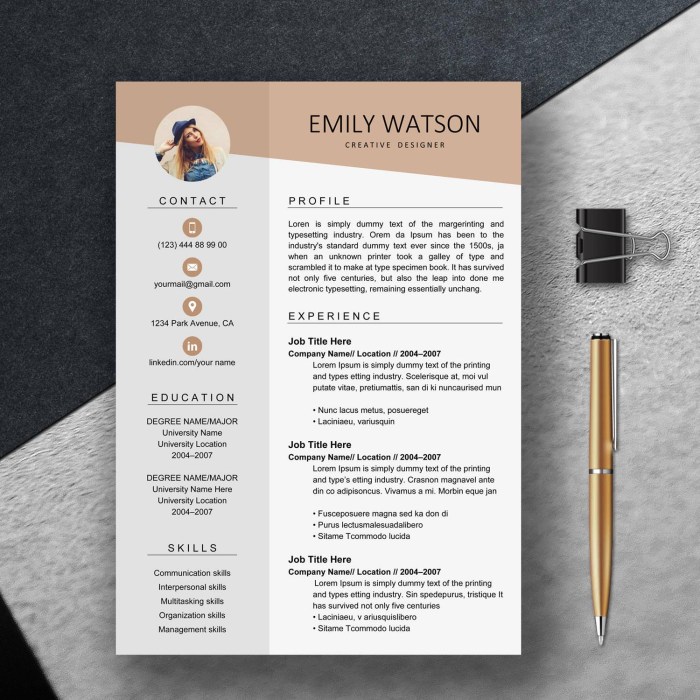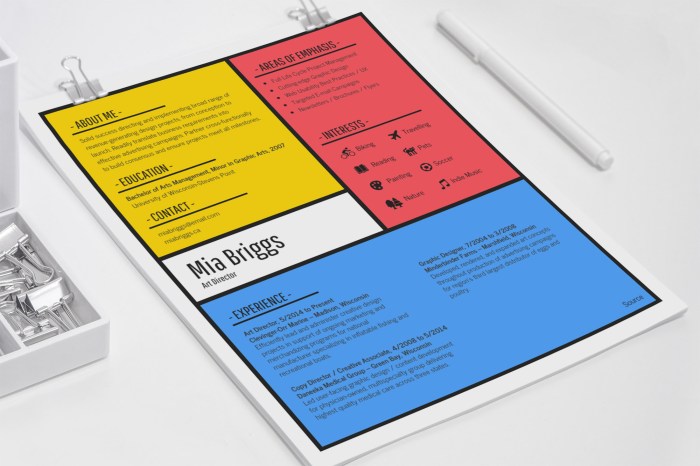Crafting a resume that truly captures your unique skills and personality is crucial in today’s competitive job market. This guide delves into the art of designing a creative resume, moving beyond the standard template to create a visually compelling and effective document that showcases your talents and helps you stand out from the crowd. We’ll explore strategies to tailor your design to specific industries, utilize impactful visual elements, and select the optimal format to highlight your accomplishments.
From understanding your personal brand and target audience to mastering the nuances of layout, typography, and color palettes, we provide a comprehensive approach to resume design. We will examine different resume formats, discuss effective use of whitespace, and demonstrate how to incorporate visuals strategically to enhance readability and engagement. The goal is to equip you with the tools and knowledge to create a resume that not only presents your qualifications but also reflects your individual style and aspirations.
Understanding Your Brand and Target Audience

Crafting a resume that truly stands out requires a deep understanding of your personal brand and the specific audience you’re targeting. Your resume isn’t just a list of accomplishments; it’s a visual representation of your skills, personality, and professional aspirations. By carefully considering your brand and tailoring your design to the target audience, you significantly increase your chances of making a lasting impression.
Your resume’s design choices communicate subtle yet powerful messages about your personality and professional style. A minimalist design with clean lines and a muted color palette might suggest professionalism, attention to detail, and a focus on efficiency. Conversely, a more vibrant and playful design with bold typography and unconventional layouts could signal creativity, innovation, and a willingness to think outside the box. The key is to ensure the design aligns authentically with your personal brand and the image you want to project.
Resume Design Tailored to Industry and Role
Different industries and job roles have varying expectations regarding resume design. A creative field like graphic design or advertising might welcome a more unconventional and visually striking resume, showcasing the applicant’s portfolio and creative flair. The design might incorporate bold colors, unique typography, and perhaps even interactive elements. In contrast, a traditional industry like finance or law typically prefers a more conservative and formal approach. A clean, classic design with a professional font and a structured layout would be more appropriate in these contexts. The choice of fonts, color palettes, and overall layout should always reflect the specific professional context. For example, a resume for a software engineer might include subtle coding references in the design, whereas a resume for a marketing manager might highlight visual appeal and data visualization skills.
Hypothetical Target Audience and Resume Layouts
Let’s consider a hypothetical target audience: entry-level marketing professionals applying for roles at a tech startup. This audience values creativity, innovation, and a data-driven approach. We can design three distinct resume layouts catering to their varied expectations:
Layout 1: Modern Minimalist. This layout features a clean, minimalist design with a focus on readability and clarity. The color palette consists of neutral tones (grey, white, and a single accent color), and the typography is modern and sans-serif. Information is presented in a clear and concise manner, using bullet points and data visualization to highlight key achievements. The overall effect is professional, polished, and easy to scan.
Layout 2: Infographic Resume. This layout uses visual elements and data visualization to present information in an engaging and memorable way. Key skills and accomplishments are represented using charts, graphs, and icons. The color palette is vibrant and eye-catching, reflecting the dynamic nature of the tech startup environment. This approach showcases both analytical and creative skills.
Layout 3: Creative Portfolio Resume. This layout integrates a mini-portfolio directly into the resume, showcasing relevant work samples and projects. The design is more visually dynamic, allowing for the incorporation of images and multimedia elements. This approach is ideal for candidates with strong visual portfolios, emphasizing their creative abilities and practical experience.
Choosing the Right Format and Layout

Selecting the appropriate resume format is crucial for effectively showcasing your skills and experience. The visual presentation of your resume is just as important as the content itself; a well-designed resume grabs attention and makes a strong first impression. The choice between chronological, functional, or combination formats significantly impacts the visual flow and overall aesthetic appeal.
The visual appeal of a resume is significantly enhanced by careful consideration of format. Different formats lend themselves to different visual strategies, and understanding these nuances is key to creating a compelling document.
Chronological Resume Format: Visual Enhancement
A chronological resume, which lists work experience in reverse chronological order, benefits from a clean, linear design. This format emphasizes career progression and stability. Visual enhancements can include using clear section headings with a slightly larger font size to create visual breaks. Subtle use of bullet points with consistent spacing enhances readability. Consider using a simple, professional color palette, perhaps with a subtle accent color to highlight key skills or achievements. A well-defined white space around each section further improves visual clarity. For example, imagine a resume where each job title is in a slightly bolder font, and the dates are clearly separated from the responsibilities, all neatly aligned in columns. This creates a clean and easy-to-follow visual hierarchy.
Functional Resume Format: Visual Enhancement
The functional resume, which focuses on skills rather than work history, can be visually engaging by using a skills-based matrix or a visually appealing chart to present skills and abilities. Color-coding skills based on categories (e.g., technical, communication, leadership) adds a visual dimension. This format is ideal for individuals with career gaps or those looking to transition to a new field. The challenge is to present the information in a way that doesn’t appear cluttered or overwhelming. For example, a bar chart showing proficiency levels in different software programs can be both visually appealing and informative. A well-designed functional resume uses ample white space to prevent the information from appearing cramped and allows the reader’s eye to flow easily through the sections.
Combination Resume Format: Visual Enhancement
A combination resume merges elements of both chronological and functional formats. It allows you to highlight key skills upfront while still providing a detailed work history. Visual appeal is achieved by strategically using visual dividers or subtle color changes to separate the skills section from the experience section. This creates a visually distinct separation without being jarring. For example, a thin line or a change in background color can effectively distinguish between the two key sections. A combination resume might use a bold font for the skills section to draw attention to those key capabilities.
Non-Traditional Resume Layouts
Moving beyond traditional formats, infographic and portfolio-style resumes offer unique visual opportunities.
An infographic resume visually represents your skills and experience using charts, graphs, icons, and other visual elements. The key is to maintain clarity and readability despite the visual complexity. An effective infographic resume is carefully organized and avoids excessive use of visuals that might distract from the core information. For example, a circular chart could showcase key skills, while a timeline could illustrate career progression. A visually appealing color palette and strategic use of white space are crucial for success.
A portfolio-style resume presents your work samples directly, making it ideal for creative fields. This could include links to online portfolios or actual samples embedded within the resume (depending on the job application). Visual appeal comes from the quality and presentation of the work samples themselves. A consistent visual theme and a clear structure are essential for navigation.
Effective Use of Whitespace, Typography, and Color Palettes
Whitespace is crucial for readability. Sufficient margins, spacing between sections, and ample room around text elements prevent a cluttered appearance. Typography choices significantly impact readability. Use a professional, easy-to-read font like Arial, Calibri, or Garamond. Avoid overly stylized or decorative fonts that might be difficult to read. A consistent font size and style throughout the resume improves visual harmony.
Color palettes should be professional and reflect your personal brand. Avoid using too many colors; a simple palette with one or two accent colors is usually sufficient. Consider using a color palette that complements your chosen font and overall design. The color choices should not be distracting, but rather enhance the readability and overall professional appearance of the resume. For instance, a combination of dark grey text on a light cream background with a single accent color (e.g., a deep blue or teal) creates a sophisticated and professional look. Using a contrasting color for headings and subheadings can further enhance visual clarity and structure.
Content and Visual Presentation

Crafting a visually appealing and informative resume requires careful consideration of both the content and its presentation. The goal is to effectively communicate your skills and experience in a way that is both engaging and easy to understand, ultimately leaving a lasting positive impression on potential employers. This involves strategically selecting methods for showcasing your achievements and incorporating visual elements that complement, rather than distract from, the core information.
Methods for Showcasing Skills and Achievements
Different methods exist for presenting your skills and accomplishments. The best approach often involves a combination of techniques tailored to your specific experience and the job you’re applying for. The following table compares several common methods, highlighting their strengths and weaknesses.
| Method | Description | Pros | Cons |
|---|---|---|---|
| Bullet Points | Concise statements summarizing achievements and responsibilities. | Easy to read, clear and concise. | Can become monotonous if overused; may lack visual impact. |
| Charts (e.g., bar charts, pie charts) | Visual representation of quantifiable achievements (e.g., sales figures, project completion rates). | Highly impactful, quickly conveys data. | Can be difficult to implement cleanly; requires data suitable for chart representation. |
| Icons | Symbolic representations of skills or accomplishments (e.g., a graph icon for analytical skills, a trophy icon for awards). | Visually appealing, adds personality; can break up text. | Requires careful selection to avoid clutter; may not be appropriate for all professions. |
For responsive design, consider using the following table structure (adaptable to 4 columns):
<table style="width:100%;">
<tr>
<td>Content</td>
<td>Content</td>
<td>Content</td>
<td>Content</td>
</tr>
<tr>
<td>Content</td>
<td>Content</td>
<td>Content</td>
<td>Content</td>
</tr>
</table>
Incorporating Visual Elements
Visual elements can significantly enhance your resume’s impact. However, it’s crucial to use them judiciously. Overuse can be distracting and unprofessional. For example, a subtle background texture with a muted color palette can add visual interest without overwhelming the content. Icons representing key skills, such as a network icon for networking expertise or a speech bubble for communication skills, can effectively illustrate your abilities. Infographics, if used sparingly and relevantly, can present complex data in a more engaging way. For instance, a small infographic depicting project workflow could demonstrate your project management skills. Imagery should always be relevant to the profession and should not be overly stylized or distracting. A simple, clean design is key. Avoid flashy animations or overly saturated colors.
Highlighting a Significant Accomplishment
Let’s say a significant accomplishment was “Increased sales by 25% in Q3 2023 through a targeted social media campaign.” This could be visually represented using a progress bar.
The progress bar would visually show the 25% increase, making the impact immediately clear. The bar could be colored in a vibrant, but not overly bright, shade of green to symbolize growth. Below the progress bar, a concise description of the accomplishment and the methods used could be included. The design choice is effective because it provides a quick visual representation of a quantifiable achievement, making it more memorable than a simple textual description. The use of color further enhances the impact, associating the positive result (sales increase) with a positive color. The clean and simple design ensures the focus remains on the accomplishment itself, avoiding any distractions.
Wrap-Up

Ultimately, designing a standout resume is about creating a cohesive and visually appealing representation of your professional brand. By carefully considering your target audience, selecting the right format and layout, and incorporating strategic visual elements, you can craft a resume that not only effectively communicates your skills and experience but also leaves a lasting impression on potential employers. Remember, your resume is your first impression – make it count.